

Table of contents
- How are forest plants classified?
- vegetation of the soil layer
- mosses
- Mushrooms
- Low flowering plants
- growth of the herbaceous layer
- grasses
- ferns
- flowering plants
- growth of the shrub layer
- The tree layer
- Native conifers
- Native deciduous trees
- Special plants in the deciduous forest
- Early flowering plants
- Plant species in the coniferous forest
Forests in this country are mostly so-called commercial forests, the trees are used as timber for houses and furniture or as firewood. It is often forgotten that this is an amazing ecosystem that is home to a wide variety of flowering and green plants (and animals too). But not every forest is the same, not only the trees vary, but all the plants in the forest.
How are forest plants classified?
On the one hand, forests are divided into deciduous, mixed and coniferous forests according to the type of trees. Other forest plants can also be classified according to their height. If you look at the forest like a house, then the root area forms the basement, so to speak, in which various animals live, green plants are not to be found there. The bottom layer forms the ground floor. Lichens, mosses and mushrooms (probably the most commonly consumed plants in the forest) grow here. The first floor with numerous plant species is called the herb layer. It is about 1.50 meters high. Herbs, grasses, ferns and flowering plants can be found here. The shrub layer on the second floor is very species-rich, with a height of up to around five metres. The tree layer forms the attic.
vegetation of the soil layer
The soil usually has much more life than meets the eye at first glance. In addition to insects and microorganisms, you can also find beautiful forest plants on the forest floor.
mosses
Cypress or sleeping moss(Hypnum cupressiforme)
- used to be dried and used as a pillow filling
- very rich in form and variable in appearance
Gooseneck star moss(Mnium hornum)
- 2 to 5 cm high
- likes to spread like a lawn
Mushrooms
toadstool(Amanita muscaria)

- toxic, narcotic
- in deciduous and coniferous forests
- like birch and spruce
death cap mushroom(Amanita phalloides)
- deadly poisonous
- in deciduous forests
chestnut bolete(Boletus badius)

- edible
- preferred in coniferous forests (spruce and pine)
chanterelle(Cantharellus cibarius)

- edible
- mossy soils in deciduous and coniferous forests
mushroom(boletus edulis)

- edible
- in deciduous and coniferous forests
forest mushroom(Agaricus silvaticus)
- edible
- in coniferous forests, preferably with spruce
Tip:
Only collect mushrooms that you know really well, many edible varieties have an inedible or even poisonous counterpart. At special mushroom seminars you can deepen your knowledge and learn a lot about mushrooms.
Low flowering plants
elf flower, sock flower (epimedium)
- Height: 20 to 35 cm
- Leaves: ovate to ovate-lanceolate, serrate margin, basal or distributed on stem
- Blossoms: white, yellow or pink, dainty, fourfold
- heyday: early summer
Ordinary hazel root, witch smoke, envy herb, glandular herb (Asarum europaeum)
- Location: preferably in deciduous and mixed forests
- Leaves: Roundish to kidney-shaped, hairy underneath
- Blossoms: pitcher-shaped, brown-red, with 3 tips
- heyday: March to May
- Particularities: evergreen, smells slightly peppery
wood sorrel (Oxalis acetosella)

- Location: preferably in mixed and coniferous forests
- Height: 5 to 15 cm
- Leaves: grass-green, tripartite, clover-like pinnate, taste sour
- Blossoms: white or pink
- heyday: April to June
growth of the herbaceous layer
Not only do many creatures hide here, but also many plants in the forest. If you go for a walk in the forest with your eyes open, you will discover a lot.
grasses
wire hairbrush(Deschampsia flexuosa)
- sweet grass
- grows on acidic and lean soils
Common trembling grass(Braz media)
- sweet grass
- lean soil
- found in clearings
ferns
(Forest) lady fern(Athyrium filix femina)
- deciduous
- Fronds 30 cm to 1 m long
Common Thorn Fern(Dryopteris carthusiana)
- fronds up to 90 cm long
True Male Fern(Dryopteris filix-mas.)
- green until winter
- Fronds 30 cm to 1 m long
flowering plants
common heather, heather, (Calluna vulgaris)

- Location: prefers sparse (pine) forests, heathland
- Height: 30cm to 1m
- Leaves: small, leathery, close-fitting scales
- Blossoms: dense racemose inflorescences with white, pink or purple flowers
- heyday: Late summer to fall
- Particularities: evergreen dwarf shrub, woody
blueberry, Blueberry, Bickberry, Cranberry (Vaccinium myrtillus)
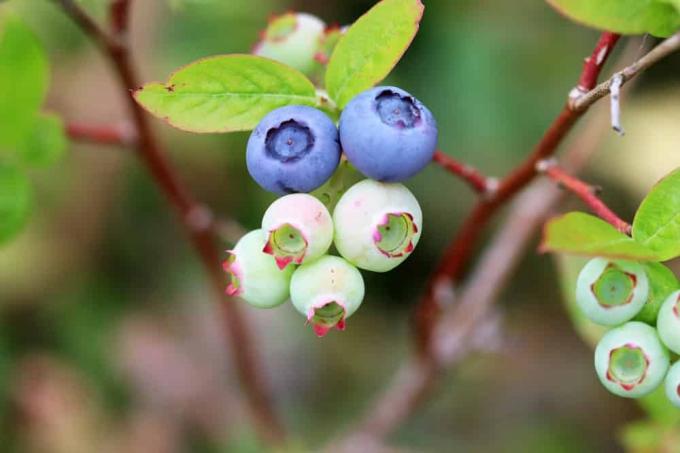
- Location: in pine and mixed forests
- Height: Dwarf shrub, 10 to 60 cm
- Leaves: Grass green, 2 to 3 cm long, ovate to elliptic, slightly serrate to finely toothed
- Blossoms: greenish to reddish
- heyday: April May
- Fruit: black-blue berries up to 1 cm in size, solitary, slightly flattened, edible
red foxglove, fox herb, forest bells (digitalis purpurea)

- Location: prefers light coniferous forest
- Height: up to 2 m high
- Leaves: Basal rosette in the first year, later basal leaves up to 20 cm long
- Blossoms: red-purple flowers in racemose inflorescences
- heyday: June to August, only in the second year
- Particularities: deadly poisonous in all parts of the plant, even in small amounts!
Stinking Hellebore(Helleborus foetidus)
- Location: Oak and beech forests, forest edges, likes slightly calcareous soil
- Height: until about. 60 cm
- Leaves: unpleasant smell
- Blossoms: light green, occasionally with a slightly reddish edge, in clusters, hanging, appear as early as autumn
- heyday: late winter, early spring
- Particularities: subshrub, poisonous
deadnettle(lamium)
- Height: 20 to 80 cm
- Leaves: opposite, hairy, bluntly crenate to coarsely toothed
- Blossoms: Lip flowers, upper lip arched, lower lip multilobed, white, yellow, pink to purple
- heyday: depending on the variety from April until the first frost
forest goat's beard(Aruncus dioicus)
- Height: 80cm to 1.5m
- Leaves: Leaves up to 1 m long, in twos or threes in threes or fives, sharply toothed
- Blossoms: white, small, spiked partial inflorescences arranged on overhanging whole inflorescences
- heyday: June to July
wild burgundy, Many-flowered claret (Polygonatum multiflorum)
- Height: usually 30 to 60 cm, rarely up to 1 m
- Leaves: Dark green above, grey-green dusting underneath, alternate, in two rows, ovate to elliptical, 5 to 17 cm long
- Blossoms: white with green tips, 6 to 7 mm long, odorless, inflorescences with 3 to 5 flowers
- heyday: May to June
- Fruit: dark blue to black berries, frosted, 7 to 9 mm in size
- Particularities: Toxic in all parts of the plant
growth of the shrub layer
The shrub layer is usually more pronounced in sparse forests and almost non-existent in dark coniferous forests. Forest edges and clearings are particularly rich in species.
blackberries(Rubus sectionio rubus)
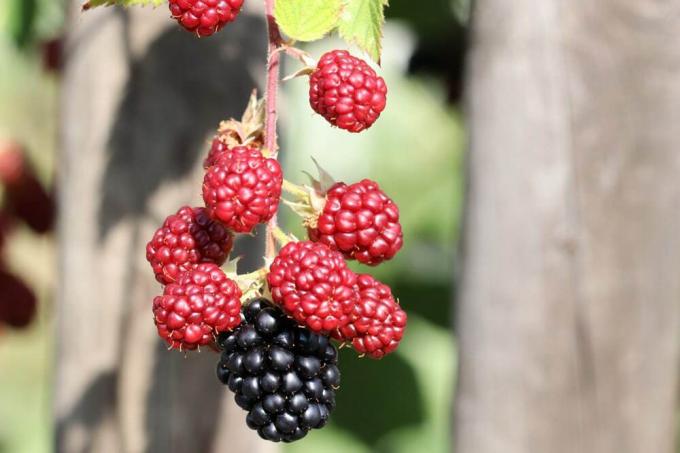
- in sparse forests
hazelnut(Corylus avellana)

- in sparse forests, at forest edges
raspberries(Rubus idaeus)
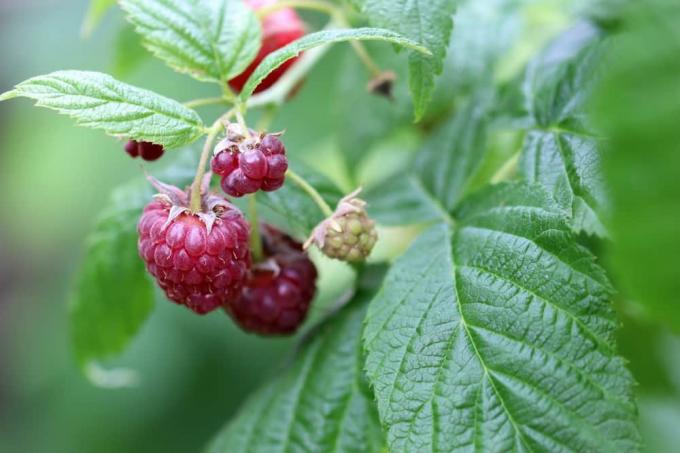
- at forest edges and in clearings
dog rose(Rosa canina)
- in sparse forests and at the edges of forests
blackthorn(Prunus spinosa)
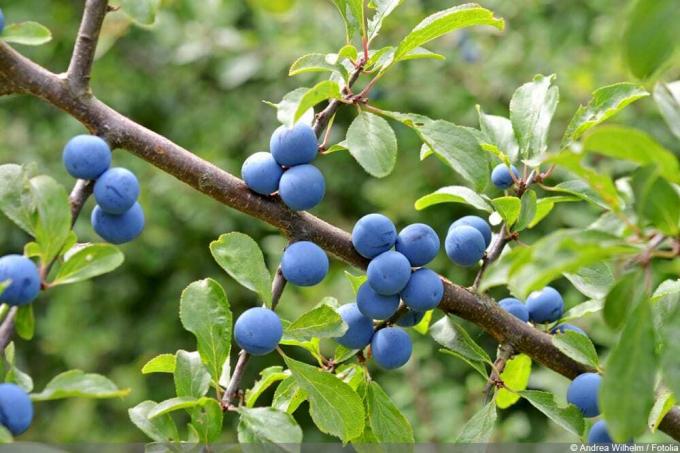
- at forest edges
- is considered a butterfly plant
Black elder(Sambucus nigra)

- on forest clearings
- unripe berries are poisonous
- ripe ones should only be eaten when heated
rowanberry(Sorbus aucuparia)
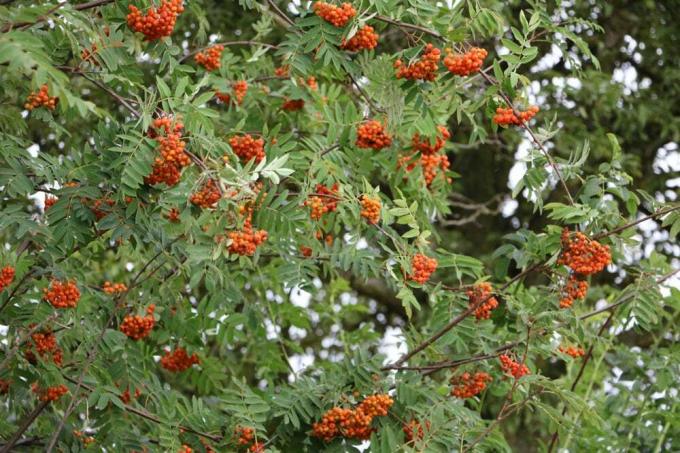
- small apple-like fruits
- important food plant for many animals
- in all forests, preferably at the edge of the forest
hawthorn(Crataegus)
- in sparse deciduous and pine forests
- edible fruits
The tree layer
The tree layer is formed by the different deciduous and coniferous trees, probably the most important plants in the forest. Spruce and beech in particular can be found here, but also pine, fir, oak, maple and larch and, increasingly, Douglas fir.
Native conifers
douglas fir(Pseudotsuga menziesii)
- foreign conifer (is grown in forests in Europe)
- up to 50 m high
- Crown: conical, similar to spruce
- Tribe: cylindrical, straight
- Bark: smooth, grey, with resin bumps, later reddish to dark brown, thick bark, deeply fissured
- needles: soft, green on top, 2 light stripes underneath, flat, aromatic fragrance
- cones: 5 to 10 cm long, hanging, light brown
Spruce(Picea abies)

- up to 50 m high
- Crown: slender, conical
- Tribe: columnar
- Bark: grey-brown to red-brown, thinly scaly
- needles: dark green, square, perched around the twig
- cones: hanging, 10 to 16 cm long
Jaw(Pinus sylvestris)

- up to 40 m high
- Crown: umbrella-like
- Tribe: mostly straight
- Bark: thick gray-brown bark below, thin, reddish-yellow and flaking on top
- needles: 3 to 7 cm long, on short shoots, blue to grey-green
- cones: ovoid, grey-brown, short-stalked
larch(Larix decidua)

- up to 50 m high
- Crown: slightly conical
- Bark: deeply furrowed, grey-brown, red inside
- needles: soft, light green, in clusters on short shoots, golden yellow in autumn, needleless in winter
- cones: 3 to 4 cm long, ovate, brown, erect
(silver) fir (Abies alba)
- up to 50 m high
- Crown: rather flattened, like a stork's nest
- Trunk: straight
- Bark: whitish to silver-grey, finely fissured
- Needles: Underside with 2 white longitudinal stripes, upper surface dark green, flat
- Cones: only in the top area, erect, 10 to 15 cm long
Native deciduous trees
sycamore(Acer pseudoplatanus)
- up to 30 m high
- Bark: smooth, brown-grey, later flaking off in light brownish flat scales
- Leaves: long-stalked, opposite, 5-lobed (like 5 fingers), pointedly indented
- Fruit: composed of 2 winged round nuts
Norway maple (Acer platanoides)
- up to 30 m high
- Bark: blackish, finely fissured, not flaking
- Leaves: 5 to 7 lobes, blunt incision (round), toothed
- Fruit: composed of 2 winged flat nuts
ash(Fraxinus excelsior)
- up to 40 m high, but mostly 15 to 20 m
- Crown: mostly light
- Tribe: long and straight
- Bark: first greenish, then gray to grey-brown, with reticulations
- Leaves: opposite, imparipinnate, mostly 11 serrate leaflets
- Fruit: small winged nuts, mostly single-seeded, oblong, yellow-brown, in hanging, tufted panicles
hornbeam(Carpinus betulus)

- up to 25 m high
- Tribe: strong indentations
- Bark: silver grey, smooth
- Leaves: in two lines, alternate, pointed-ovoid, sharply doubly serrated, folded along the parallel lateral veins
- Fruit: small nuts, one-seeded, in loosely hanging catkins
European beech (Fagus sylvatica)
- up to 40 m high
- Tribe: long, straight
- Bark: smooth, silver-grey
- Leaves: alternate, in two rows, smooth or slightly wavy margins
- Fruit: triangular beechnuts, shiny brown, prickly shell
pedunculate oak (Quercus robur)
- up to 35 m high
- Crown: irregular, loose
- Tribe: relatively short, branched early
- Bark: first silver-grey, smooth and shiny, from about 30. year grey-brown and deeply fissured
- Leaves: alternate in clusters, 4 to 5 rounded lobes on both sides
- Fruit: cylindrical acorns, in bowl-shaped cups, 1 to 3 each on a long stalk
sessile oak (Quercus petraea)
- up to 40 m high
- Crown: irregular
- Tribe: long
- Bark: first silver-grey, smooth and shiny, from about 30. year grey-brown and deeply fissured
- Leaves: alternate, evenly distributed, 5 to 7 rounded lobes on both sides
- Fruit: cylindrical acorns, in cup-shaped cups, in clusters (3 to 7) on a short stalk
Special plants in the deciduous forest
So-called early bloomers can be found in many deciduous forests. They bloom in the spring, before the trees sprout and the dense foliage darkens the forest. Native early bloomers are a very important food source for insects as they provide the first nectar of the year.
Early flowering plants
wild garlic, wild garlic, forest or dog garlic (Allium ursinum)

- preferred location: moist soil and beech forests
- Height: 20 to 30 cm
- Leaves: green, upper surface slightly darker than underside, lanceolate, stalked
- Blossoms: white, radially symmetrical flowers in flat umbels
- heyday: April to May
- Particularities: edible wild vegetables, related to onion, chives and garlic, taste slightly garlic-like
Likelihood of confusion:
Leaves can easily be mistaken for those of lily of the valley, spotted arum (young leaves are unspotted) or autumn crocus, these plants are highly toxic!
wood anemone(Anemone nemorosa)

- Height: 11 to 25 cm
- Leaves: stalked, finger-shaped, appear only after flowering
- Flowers: 6 to 8 petals, white, slightly pink on the outside, usually only one flower per plant, rarely 2
- Flowering time: March to April/May
Common butterbur(Petasites officinalis)
- Height: during flowering approx. 10 to 40 cm, later up to 1.20 m
- Leaves: Roundish, initially small with a gray woolly hairy underside, later up to 60 cm in diameter and smooth, similar to coltsfoot but much larger
- Blossoms: numerous dense reddish-white to red-purple flowers, compound racemose inflorescence
- heyday: March to May
Lesser Celandine, Figwort(Ficaria verna, Ranunculus ficaria L.)
- Height: 10 to 20 cm
- Leaves: undivided on long stalks, heart-shaped to kidney-shaped
- Blossoms: yellow, star-shaped, diameter 1.5 to 6 cm, solitary
- heyday: March to May
- Particularities: Poisonous in all parts, young leaves edible as weeds before flowering
woodruff, Fragrant bedstraw (Galium odoratum)

- Height: 5 to 50 cm
- Leaves: Whorled on the stem, narrowly elliptic or elongate-lanceolate, rough edge
- Blossoms: small and white, several flowers per plant, terminal inflorescence
- heyday: variable depending on location, around April to May or June
- Particularities: is used as a medicinal and aromatic herb, the main component of the woodruff punch
Plant species in the coniferous forest
Different plants grow in coniferous forests than in deciduous forests. Shade plants in particular feel at home here. This is due to the low incidence of light, because most conifers have needles all year round. The only exception to the native conifers is the larch, which sheds its needles in autumn. In addition, the soil in coniferous forests is usually more acidic, the falling needles rot much more slowly than leaves, which means that the humus layer is relatively thick. Wood sorrel, mosses and ferns can be found here, as well as common foxglove and heather in clear areas.
 garden editorial
garden editorial I write about everything that interests me in my garden.
Learn more about W for juniper

Wollziest, Stachys byzantina: Dog-ear care instructions
The Wollziest is a robust and easy-care plant that presents itself with soft, hairy, silver-grey leaves. If the conditions in terms of care, location and substrate are right, the perennial will thrive. The plant can be cultivated both in the garden and in the bucket.
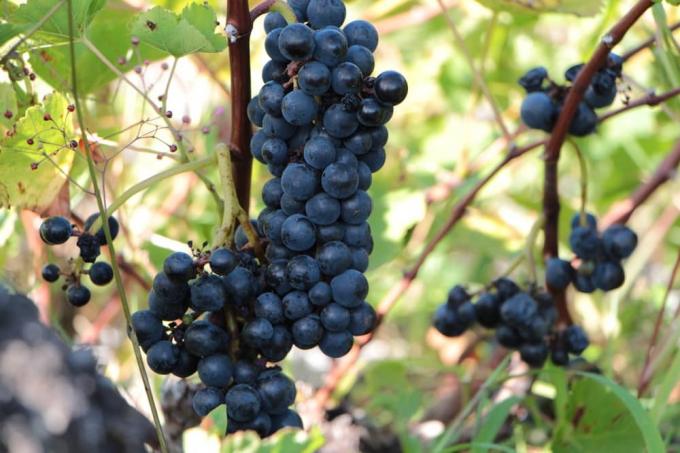
Grapevine, Vitis: care from A-Z | 21 tips for your own grapes
Grapes from your own garden are not just a fresh snack for in between. There are numerous grape varieties around the world. Table vines or table grapes, which were specially bred for fresh consumption, are particularly suitable for cultivation in the home garden.

What are wild shoots? How to recognize wild shoots in roses
At first, wild shoots appear quite inconspicuous, but due to their vigorous growth, they soon displace the weaker hybrid tea rose. Therefore, you should remove these shoots as soon as possible. But be careful: Not everything that looks like a wild instinct is actually one. How to detect the unwanted branches.

Rocket juniper, Juniperus scopulorum: care tips
The rocket juniper (Juniperus scopulorum) is also known as columnar juniper and can reach impressive heights. Here we show how it can be cultivated successfully. There are also some care tips that can strengthen growth and the plant.

Keep conifers in the bucket - thuja, cypress and rocket juniper
Evergreen trees and shrubs are an attractive sight all year round because they do not shed their leaves in autumn. Thuja, cypress, and rocket juniper all thrive in pots, provided their needs are considered and they are given the right care.
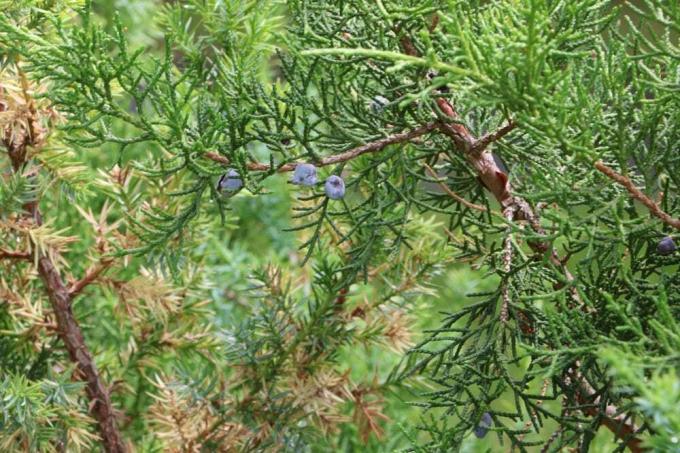
Cut juniper - as a hedge, bonsai and solitary plant
As a key element in creative garden design, juniper enjoys worldwide popularity. Its frugal cut tolerance contributes significantly to this. This applies to cultivation as an elegant hedge, artistic bonsai and eye-catching specimen. Here you can find out how to professionally trim a juniper so that it retains its individual silhouette for many years.



